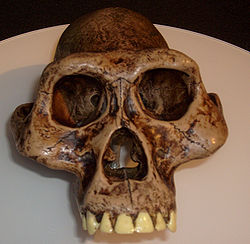Australopithecus
Australopithecus[1] is a genus of extinct hominids closely related to humans.
| Australopithecus Temporal range: Pliocene
| |
|---|---|

| |
| Australopithecus afarensis | |
| Scientific classification | |
| Kingdom: | |
| Phylum: | |
| Class: | |
| Order: | |
| Family: | |
| Genus: | Australopithecus R.A. Dart, 1925
|
| Species | |

The first Australopithecus described was the Taung Child, discovered by Raymond Dart, and described in 1925.
Their remains are mostly found in East Africa, and the first fossil is from 3.9 million years ago (mya). The split from other apes would have taken place earlier, perhaps about 5 mya.
It is widely believed that the group of which they are part gave rise to the genus Homo, and hence to human beings.[2]
The genus Australopithecus originally included two rather different forms. One form was lightweight: the gracile australopithecines. The other form was bulkier, the robust australopithecines.
It is still under discussion whether they should be put in separate genera. Here we treat the gracile forms; the robust forms are described elsewhere as Paranthropus.
Gracile australopithecines shared several traits with modern apes and humans. They were widespread throughout Eastern and Northern Africa 3.9 to 3 million years ago.
Morphology
changeSkull
changeBrain size
changeThe brains of most species of Australopithecus were roughly 35% of the size of that of a modern human brain. This is not much more than the brain of a chimpanzee. Brain size in hominins does not increase significantly until the arrival of the genus Homo.
Other features
changeThe Taung specimen had short canine teeth, and the position of the foramen magnum was evidence of bipedal locomotion.[3]
Skeleton
changeMost species of Australopithecus were diminutive and gracile, usually standing between 1.2 and 1.4 m tall (approx. 4 to 4.5 feet). There is a considerable degree of sexual dimorphism. Modern hominids do not show sexual dimorphism to the same degree — particularly, modern humans display a low degree of sexual dimorphism, with males being only 15% larger (taller, heavier) than females, on average.
In Australopithecus, however, males can be up to 50% larger than females, though usually less pronounced than this.[4]
Summary
changeThe skeleton, the fossil footprints found at Laetoli,[5] Tanzania, the canine teeth and the foramen magnum all show that these apes had achieved bipedalism.
Evolution
changeAustralopithecus africanus used to be regarded as ancestral to the genus Homo (in particular Homo erectus).
However, fossils assigned to the genus Homo have been found that are older than A. africanus. Thus, the genus Homo either split off from the genus Australopithecus at an earlier date (the latest common ancestor being A. afarensis or an even earlier form, possibly Kenyanthropus platyops), or both developed from a common ancestor independently.
According to the Chimpanzee Genome Project, both human (Ardipithecus, Australopithecus and Homo) and chimpanzee (Pan troglodytes and Pan paniscus) lineages diverged from a common ancestor about 5 to 6 million years ago, if we assume a constant rate of evolution.
However, hominins discovered more recently are somewhat older than the molecular clock would suggest. Sahelanthropus tchadensis, commonly called "Toumai" is about 7 million years old and Orrorin tugenensis lived at least 6 million years ago. Since little is known of them, they remain controversial because the molecular clock in humans has determined that humans and chimpanzees had an evolutionary split at least a million years later.
One theory suggests that the human and chimpanzee lineages diverged somewhat at first, then some populations interbred around one million years after diverging.[6] More likely, the assumptions behind molecular clocks do not hold exactly. The key assumption behind the technique is that, in the long run, changes in molecular structure happen at a steady rate. Researchers such as Ayala have challenged this assumption.[7][8][9]
Related pages
changeReferences
change- ↑ Latin australis = 'of the south', Greek pithekos = 'ape'
- ↑ Leakey, Richard 1994. The origin of humankind. New York: BasicBooks. ISBN 0465031358
- ↑ The foramen is a hole in the bottom of the skull, through which the spinal cord joins the brain. In apes it is positioned at the rear of the skull, in humans near the middle. The foramen of a bipedal ape would be expected to be more like humans.
- ↑ Beck, Roger B. (1999). World history: patterns of interaction. Linda Black, Larry S. Krieger, Phillip C. Naylor, Dahia Ibo Shabaka. Evans ton, IL: McDougal Littell. ISBN 0-395-87274-X.
- ↑ These footprints have been dated to 3.7 million years ago.
- ↑ Bower, Bruce (May 20, 2006). "Hybrid-driven evolution: genomes show complexity of human-chimp split". Science News. 169 (20): 308. doi:10.2307/4019102. JSTOR 4019102.
- ↑ Ayala F.J. (1999). "Molecular clock mirages". BioEssays. 21 (1): 71–75. doi:10.1002/(SICI)1521-1878(199901)21:1<71::AID-BIES9>3.0.CO;2-B. PMID 10070256. Archived from the original on 2012-12-16. Retrieved 2011-02-28.
- ↑ Schwartz, Jeffrey H.; Maresca, Bruno (December 2006). "Do Molecular Clocks Run at All? A Critique of Molecular Systematics". Biological Theory. 1 (4): 357–371. doi:10.1162/biot.2006.1.4.357. ISSN 1555-5542. S2CID 28166727.
- ↑ Jarmila Kukalová-Peck. 2008. Phylogeny of higher taxa in insecta: finding synapomorphies in the extant fauna and separating them from homoplasies. Evolutionary Biology 35, 4-51